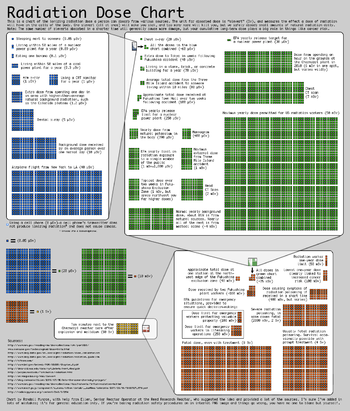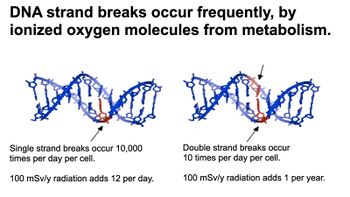Radiation Hazards
- See also: Nuclear_power_reconsidered

One of the primary obstacles to nuclear power is the public's fear of radiation. While ionizing radiation can certainly be dangerous at high doses, people have difficulty distinguishing between a little and a lot, so that this has often been oversimplified to, "The only acceptable amount of radiation is zero!" That goal can never be met, since (for example) all living things are radioactive. A sensible criterion must be based on an understanding of where radiation comes from, what sorts of damage radiation does, and how much of which kind of radiation it takes to do it.[1]
Figure 1 compares a range of radiation exposures, from the dose received from sleeping next to another human for a night (0.05 Sv) to the usually fatal dose of 4 Sv, a hundred million times greater. Warning: such comparisons can be misleading unless one understands that some are "delivered all at once" and others are "accumulative" over times up to a year. There is great controversy over the latter, since DNA usually "heals" strand-breaks due to free radicals produced by ionizing radiation (see Fig. 2) within hours or days,[2] suggesting that whole-body doses may not "accumulate" over longer periods.
Mortality
Paraphrased from memory: Front page of special HEALTH edition of the LA Free Press (around 1970):
"No matter how much money you have, how good your health care provider or how healthy your diet and life style, you, personally, are going to die."
(I don't really want to believe this any more than you do, but I have to confess that the evidence for it is persuasive.)
Either way, it makes an excellent starting point for any discussion of hazards. We cannot (for now) avoid dying, but we can exercise some influence over when we will die and from what causes. We also (for now) get to choose how much of our enjoyment of life and liberty we sacrifice to this effort.
What is "Radiation"?
- Electromagnetic Waves:
- AM Radio, FM Radio, Shortwave Radio, TV, Cell Phones, WiFi, Microwave, Visible Light — all harmless at low intensity.
- Near Ultraviolet (UV) — beneficial at low doses (Vitamin D)
- Far UV, X-rays, Gamma-rays — damaging wherever absorbed. (Note that a sunburn is a second-degree radiation burn to the skin.)
- Fast Massive Particles:
- Electrons (-rays)
- Protons & Neutrons
- -rays (4He nuclei)
- Heavy Ion Beams
- What does the Damage?
- Enough intensity of anything will "cook" you.
- Highly reactive free radicals produced by (among other things) Ionizing Radiation.
Ionizing Radiation DNA Strand Breaks
- Single strand breaks usually heal in less than a few hours.
- Double strand breaks are sometimes permanent, causing…
- Cell Reproductive Death (most common): Cells usually survive for natural lifetimes — a few days for hair follicles, skin and mucous membrane cells; "forever" for neurons and some muscle cells.
- Genetic Mutation (most subtle): Damaged gamete cells → mutations (usually fatal to foetus; almost always detrimental to individual…)
- Cancer (most unpleasant): Runaway replicative zeal of a misguided cell…
Cancer Therapy
Most cancer radiation therapies involve radiation insults that inflict DNA damage similar to that caused by "bad" radiation.
Strategy: to kill every single cancer cell (along with up to 90% of nearby normal cells).
Dose may be more than 10,000 times maximum legal limit for "accidental" radiation exposure… but are normally not "whole body".
Why Worry, and When? (Informed Consent vs. Public Policy)
Cost/Benefit Analyses: Every public policy decision creates risks. Is this likely to do any good? How much good? Is it likely to do any harm? How much harm? What are the relative probabilities of good and harm? How many people are likely to suffer from the harm? How many people are likely to benefit from the good? And of course the two questions most popular with politicians, "Which people?" and "When?"
Any sensible policy regarding radiation hazards, whether public or personal, must take into account that each of us is going to die, that our lifespan is frustratingly short no matter what we do, and that our chances of dying of cancer (radiation-induced or otherwise) are already rather high. (Men have just over a 20% risk of dying from cancer, while women's risk is just over 18%.)
How Bad is How Much of What?
Units:
• 1 rad ≡ 100 erg/g (energy deposited per unit mass)
• 1 Gray ≡ 100 rad ≡ 1 J/kg. [SI units]
Relative Biological Effectiveness (RBE) "fudge factor":
• X-rays, γ-rays & β-rays (fast electrons): RBE = 1 (by definition)
• Slow neutrons: average RBE ≈ 3. (Variable!)
• Fast neutrons, protons & α-rays: RBE = 10.
• Fast heavy ions: RBE = 20.
REM (R, Roentgen Equivalent to Man):
• 1 R ≡ RBE × rad.
• (1 mR ≡ milliREM] ≡ 10−3 R.)
• Sievert (Sv) [Standard International unit]: 1 Sv ≡ 100 REM
EFFECTS
• Instant Death: ∼ 5000 R (50 Sieverts [Sv]) “whole-body” wipes out central nervous system (CNS) immediately when delivered all at once.
• Overnight Death: ∼ 900 R (9 Sv) whole-body usually accomplishes the same thing in about a day.
• Ugly Death: ∼ 500 R (5 Sv) → severe radiation sickness (nausea, hair loss, skin lesions, etc.) as short-lived cells fail to provide new generations to replace their normal mortality. Complications (infection) usually kill. Some recover completely but may develop leukemia 10-20 years later; offspring (if any) will likely have genetic mutations.
• Sub-Acute Exposures: ∼ 100 R (1 Sv) whole-body delivered in less than 1 week → no immediate symptoms, but possible leukemia in 10-30 years and possible genetic mutations in offspring.
• Marginal Exposures: average exposure from natural sources ∼ 300 mR (3 mSv) per year. ( = 1979 Canadian legal limit for public exposure from artificial sources)
Note that for long-lived cells like neurons and muscle cells, cumulative doses over times as long as a year have little meaning in light of the typical time scale of DNA strand-break healing. (See Ref. 2.) However, short-lived cells like skin cells replicate fast enough that even a partially damaged cell can sometimes propagate itself into a local "precancerous" population that is then vulnerable to subsequent damage leading to malignant cancer.
Different body parts have dramatically different resistance to radiation. Hands can withstand radiation doses that would kill if delivered to the whole body. The gonads and the lens of the eye are considered to be the most vulnerable.
There is some evidence (e.g. from Ramsar, Iran) for radiation hormesis (marginal exposures may actually promote better health).
Sources of Ionizing Radiation
According to the 2021 EPA survey, the average annual doses to USA population have the following sources and magnitudes:
Note that cosmic rays make a significant contribution to these accumulated doses. Fortunately our atmosphere makes an excellent shield; but since it is most dense near sea level, people living at high altitude (like Denver) receive a higher annual dose, and flying at 40,000 feet delivers about 0.7 mR per hour.
NOTE: Since rates of exposure vary constantly, the temptation to average over a year is understandable; however, for the majority of cell types, given that the only damage that matters (DNA strand breaks) usually heals on a time scale of less than days, the above numbers are almost meaningless in terms of health risk.
More useful are the "all at once" exposures we are apt to encounter:
• Medical X-rays:
- Whole Body CT scan: 1,000 mR (10 mSv) per exposure
- Upper GI X-ray: 600 mR (6 mSv) per exposure
- Head CT scan: 200 mR (2 mSv) per exposure
- Mammogram: 42 mR (0.42 mSv) per exposure
- Chest X-ray: 10 mR (0.1 mSv) per exposure




